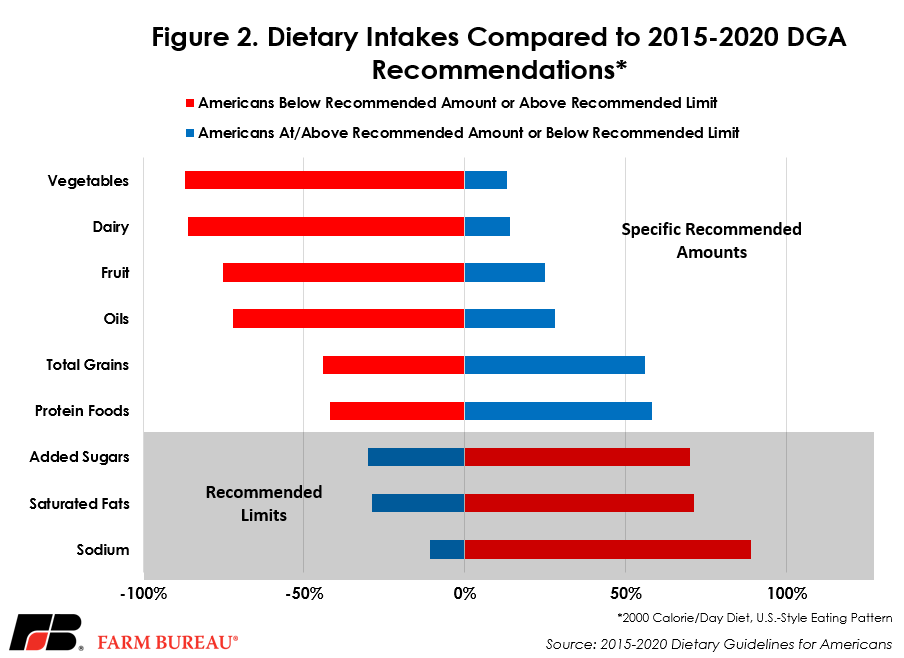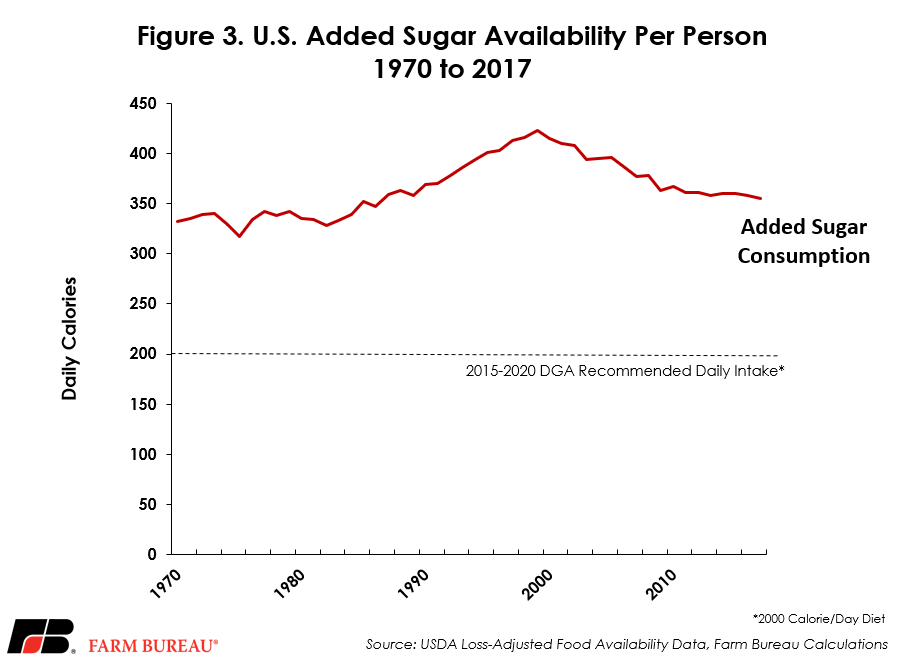A Way-Too-Early Look at the 2020 Dietary Guidelines for Americans
AFBF Staff

photo credit: Mark Stebnicki, North Carolina Farm Bureau; used with permission.
The next edition of the Dietary Guidelines for Americans will be published in 2020. Updated every five years, the DGA is a set of guidance on dietary choices and health authored by USDA and the Department of Health and Human Services. Many Americans are familiar with the old Food Guide Pyramid or the more recent MyPlate, both developed using the DGA, but the full guidance has a much broader impact because it provides direction for nutrition and health professionals, as well as federal nutrition programs. The development process for the 2020 guidelines is ongoing, but that won’t stop us from sharing a few way-too-early predictions.
Prediction 1: More Pages
First, don’t expect the guidelines to be a quick read. The guidance has become far more comprehensive since the first edition in 1980. What started as a modest 20-page booklet has grown to 122 pages by the eighth edition in 2015. (HHS has an archive of past guidelines available on its website.) The 1980 guidelines focused primarily on the relationship between diet and disease. Now the guidelines look at nutrition and health more broadly, including guidance on physical activity, different types of healthy eating patterns, and social and cultural influence on diet.
Since 2010, the DGA has also included guidance on how to help others make healthier choices on diet, physical activity and weight management. Since the DGA is written for an audience of health and nutrition professionals and policymakers, expect both more nutritional science and more guidance on how to help others make healthy choices.
Prediction 2: Some New Advice, But A Lot More of The Same
It’s unlikely that there will be radical changes in dietary recommendations in 2020. Some recommendations from the dietary guidelines now seem like conventional wisdom: eat a variety of foods from different food groups, don’t eat too much sugar or sodium. In fact, the advice mentioned above has been in every edition of the DGA for the past 35 years.
As nutrition science has improved, the recommendations in the dietary guidelines have become more nuanced. For example, the 2015 guidelines don’t just recommend fruits, vegetables and grains, they recommend whole fruits, whole grains and a variety of vegetables from different subgroups (dark green, red and orange, legumes, starchy and other). The 2015 guidelines also draw a distinction between oils and solid fats, noting health benefits from oils that provide essential fatty acids and vitamin E. Early editions of the DGA didn’t have these distinctions.
This doesn’t mean the guidance will stay the same. The 2020 guidelines will include a new section with nutrition and diet recommendations for pregnant women and children under two years old, following a mandate in the 2014 Farm Bill. (Currently the guidelines are only aimed at those ages 2 and older.)
Some significant changes have been made between 1980 and 2015. The 1995 guidelines, controversially at the time, added a recommendation of at least 30 minutes a day of physical activity for all adults. However, looking ahead to 2020, there haven’t been any recent developments in nutrition science that would suggest radical changes are coming.
Prediction 3: Most Americans Will Continue to Have A Diet Inconsistent with The Guidelines
Perhaps the most confident prediction that can be made about the ninth edition of the dietary guidelines is that most Americans won’t follow them. The American diet has changed some since the DGA started in 1980, but it’s still not close to the DGA.
One way to assess the American diet is calorie availability, which looks at what calories the market provides as an approximation for consumption. Figure 1 shows that according to USDA loss-adjusted food availability data from 1970 to 2017, consumption of meat, eggs, nuts, grains, fruits and vegetables has increased at varying rates. Dairy consumption has been flat. Meat, egg and nut consumption per person exceeds the DGA recommendations; grain consumption exceeds the recommended amount by a smaller margin; and vegetables, dairy and fruit consumption is well below the recommended amount.

Assessing nutrition intake across a population is tricky. Americans, on average, may not be eating the recommended levels of fruit, vegetables or dairy, but individuals or certain groups may be eating more or less of these foods – putting them closer or further away from the guidelines. Assuming an even distribution of calorie intake from these foods across the population, half of the population would be eating more than the intake level and the other half would be eating below it.
Figure 2 below shows distribution of food group intake across the population using data from the Centers for Disease Control and Prevention’s What We Eat In America Survey for 2007-2010. This data was used in the development of the 2015 Dietary Guidelines.

The distribution for dietary intake of most food groups is uneven. With the exception of grain and protein consumption, a significant majority of American diets are not in line with the dietary guidelines. Americans have a preference for added sugar, saturated fats and sodium, and are consuming amounts of fruits, vegetables and dairy below the recommended levels. After eight editions of dietary guidelines, food availability data for fruit, vegetables and dairy shows there isn’t a general trend toward compliance with the dietary guidelines. Food availability for sugar is also consistent with this trend of noncompliance, shown in Figure 3 below.

Overall, the changes in food consumption since 1970 don’t suggest a general trend of healthier eating or consumption habits more closely aligned with the recommended dietary guidelines. While the increase in fruit and vegetable consumption is closer to DGA recommendations, higher sugar consumption is a shift in the opposite direction. Dairy consumption has remained flat, at half the recommended level.
Fundamentally, the Dietary Guidelines for Americans is a resource for nutrition and health professionals and policymakers to help individuals make healthy dietary choices. While the U.S. as a whole isn’t eating as healthy as it should be, it’s important that people who want to make healthier diet choices have the information available to them. Nutrition education is important, which is why Farm Bureau’s policy explicitly supports teaching balanced diet guidelines following USDA nutrition recommendations.
Prediction 4: America’s Farmers and Ranchers Will Continue to Feed Us
Regardless of what the 2020 Dietary Guidelines for Americans offer, America’s farmers and ranchers will continue to produce the food all Americans need for a healthy diet.
Lee Bridgett is an incoming graduate student at the University of Reading in the United Kingdom studying food economics and marketing. Lee was a public affairs assistant at the American Farm Bureau Federation from March 2018 to September 2019.
